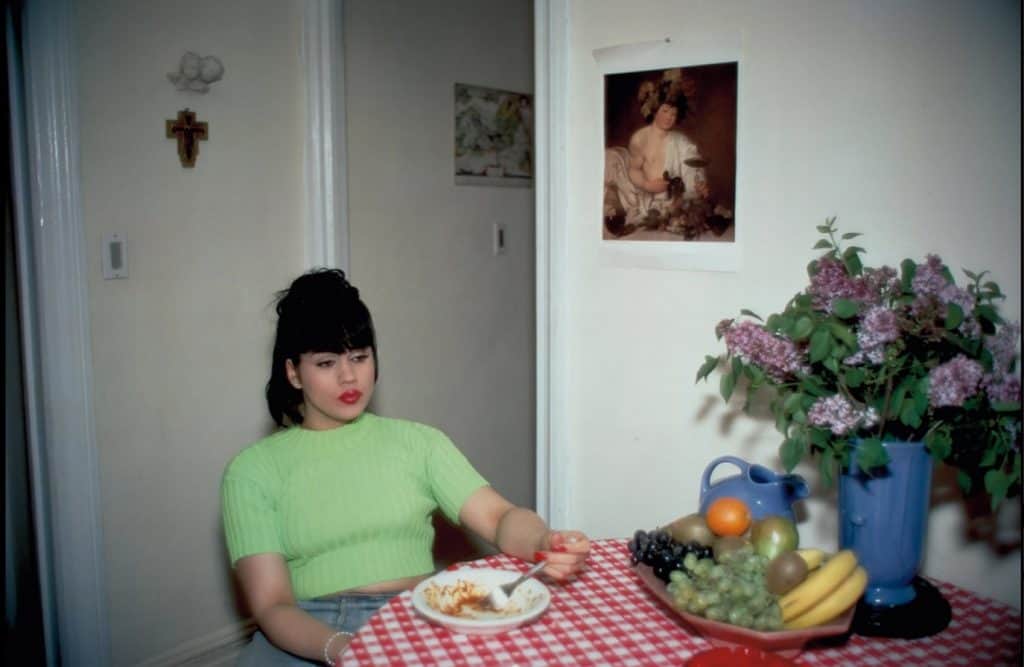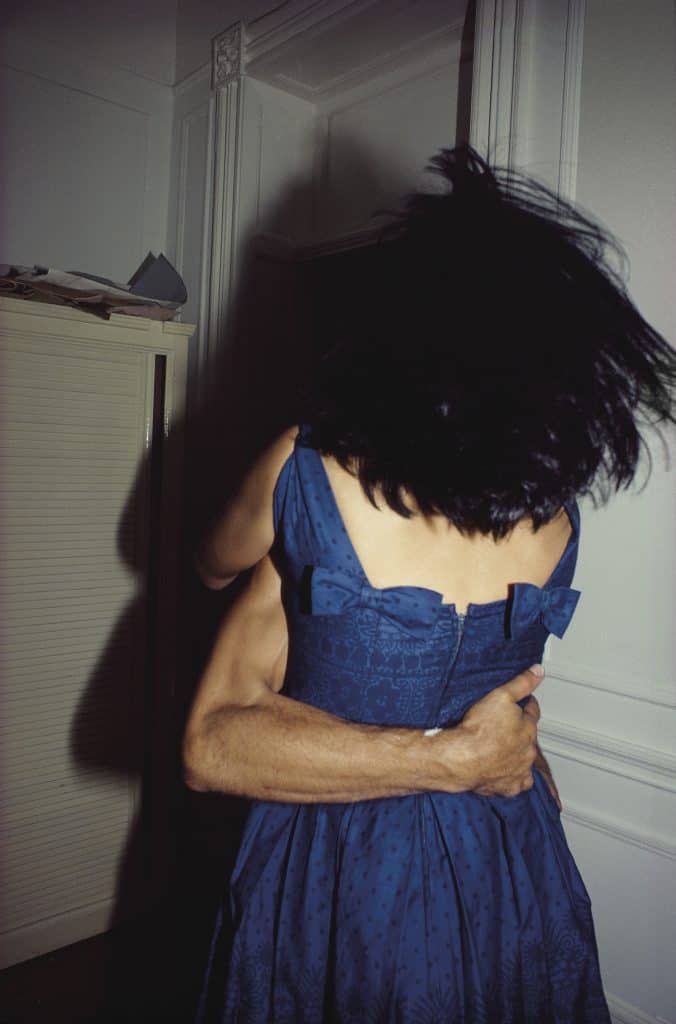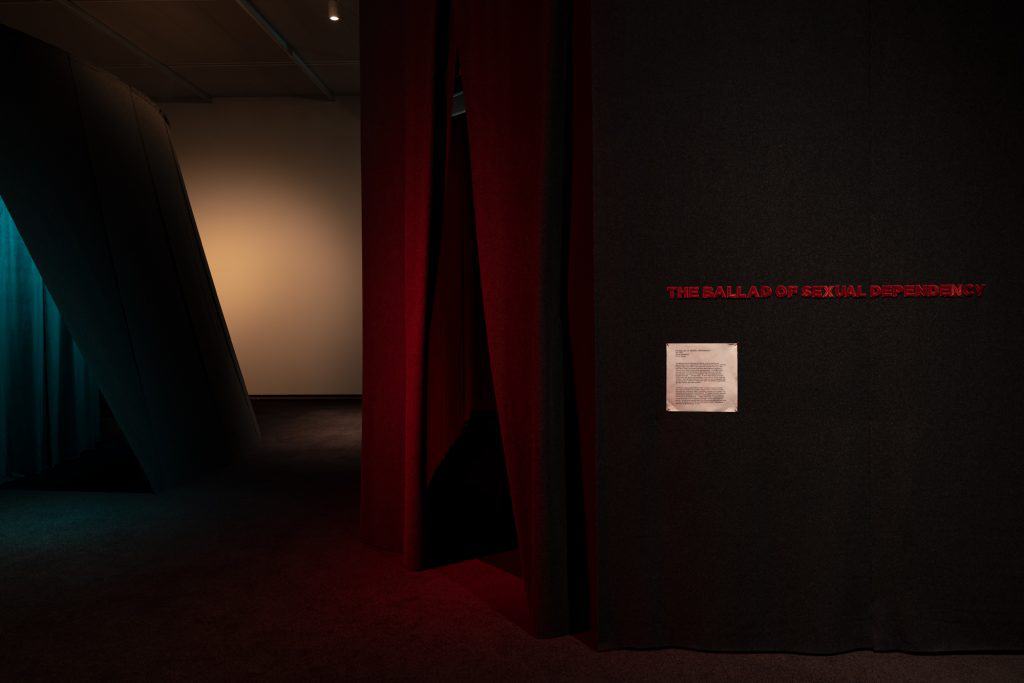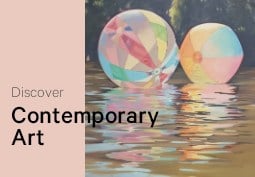Articles and Features
Nan Goldin – Revolutionizing Photography Through Daring Intimacy

By Shira Wolfe
“The camera connects me to the experience and clarifies what is going on between me and the subject. Some people believe that the photographer is always the last one invited to the party, but this is my party, I threw it.”
Nan Goldin
Nan Goldin rose to fame with her iconic photography project The Ballad of Sexual Dependency (1986), her first book which was initially conceived as an exhibition of slides. In 127 images, she documented the relationships of herself and her friends in bedrooms, bars, hotels, bordellos, cars and all the other locations that are inherent to nocturnal life. A master of the narration of the self in the private and public sphere, Goldin revolutionized photography through daringly personal and intimate portraits. She lived with her subjects, taking photographs as a tribute to her friends, to her communities, to her generation, to remember and record her chosen family.
From an early age, a rebellious Nan Goldin sought to escape the stifling confines of conventional, suburban America, finding like-minded people with whom she could find ways of expressing themselves freely, and defy notions of normality. Since she started with photography, she has explored gender, the various selves people create to feel free, the wilderness, euphoria and dark sides of drug use and nightlife – in short, all the communities and subcultures she belonged to.
Though her raw, unconventional and nocturnal life may have taken some new forms since the ‘80s, she continues to capture her subjects and her life with a great level of empathy, respect and connection. Over the past decade, alongside her intimate portraits of friends, she has been exploring new avenues such as the beauty of children and nature.
Nan Goldin’s Early Life and Beginnings in Photography
Nan Goldin was born in the suburb of Silver Spring, Maryland, near Washington D.C., in 1953, the youngest of four children. She was close with her creative and charismatic older sister Barbara, who felt unrecognised and unappreciated in the family. Stifled by her confining environment and unable to express her true identity, Barbara started acting out and her parents committed her to mental hospitals, on and off for six years. In 1965, at the age of 18, Barbara committed suicide by lying down on the tracks of a commuter train outside of Washington, D.C.
Goldin was just 11 years old, but she understood the social repression that had played a role in Barbara’s destruction and inability to cope with this life and world. In the early sixties, women who showed their emotions, anger, and sexuality were considered out of control and unacceptable, and this repression destroyed her.
Goldin herself found her way out of this constricting society by becoming a rebel who listened to the Velvet Underground, wanted to get high, got kicked out of several boarding schools, and left home at the age of 14. She lived in various communes and foster homes, and then enrolled in the Satya Community School, modeled after the British boarding school Summerhill, which was based on the concept that the school should fit the child, not the other way around, and that children had a choice in everything. At Satya, Goldin became the school photographer as Polaroid had sponsored the school with free film. She also met her best friend David Armstrong, who became a photographer too and whom Goldin credits for helping her emerge from her shell. It’s here that Goldin started shooting pictures of her self-chosen family.
“My work has always come from empathy and love. I can’t photograph anyone that I think is ugly, or disturbs me, out of anger. I photograph out of love, and out of wanting to touch someone, in some way. So I only photograph people who touch me.”
Nan Goldin
Influences and Subjects in Nan Goldin’s Work

At age 18, Goldin was living in Boston and soon became friends with a group of drag queens who spent their time at a bar called ‘The Other Side’. She started photographing them with the wish to memorialize them in all their extravagant glory. Loving their bravery in the process of creating new selves and basking in their otherness, she had no interest in taking pictures of them beneath their costumes and make-up. It was these people that they chose to be that she wanted to photograph: their chosen selves. The Other Side (1992-2021) has become one of Goldin’s most important bodies of work, celebrating her friends for bravely living out their most authentic selves.
In an interview with Thora Siemsen, Goldin touches upon the importance of friendship, on how friends were always more important to her than romantic relationships. When asked how she deals with friendships that have ended, she says she has never really gotten over them. It is exactly this moving and painful depth of emotion and connection that is palpable when looking at Goldin’s photographs.
Goldin was never really taken by camera culture and did not care much for the technical side of photography. In essence, she had always wanted to be a filmmaker. As a result, she worked with slides for most of her career, which she exhibited as slideshows, creating a kind of films in themselves. She was greatly influenced by the work of Larry Clark, who had photographed teenagers in 1960s Tulsa using drugs and having sex, and also directed the controversial movie Kids from 1995, which portrayed New York City teenagers getting lost in a world of drugs, sex and the AIDS epidemic.
In the summer of 1976, while living in Provincetown, Goldin took many pictures of her friends living it up at the beach and in their homes. She also met the writer and actress Cookie Mueller, who had appeared in several John Waters movies. She was incredibly taken by Mueller and started photographing her. In her photography book from 1991, Cookie Mueller, Goldin writes:
“She was a cross between Tobacco Road and a Hollywood B-Girl, the most fabulous woman I’d ever seen. . . . That summer I kept meeting her at the bars, at parties and at barbecues with her family—her girlfriend Sharon, her son Max, and her dog Beauty. Part of how we got close was through me photographing her—the photos were intimate and then we were.”
A Selection of Nan Goldin’s Photography Series

The Battle of Sexual Dependency
The Ballad of Sexual Dependency (1986) was Nan Goldin’s first book and remains her best-known work to this day. The book was drawn from an exhibition of 127 slides that Goldin created of relationships between her friends, herself and her partners, and people in her surrounding communities. The photographs are rough, not heavily stylized or composed, instead colorful flashes of people’s dreams, conflicts, and desires. Goldin has described The Ballad of Sexual Dependency as the last dance, before that world as she knew it, and the people that colored it, was swallowed by the AIDS epidemic.
In The Ballad of Sexual Dependency, what jumps out from the photographs is the intimacy, trust and empathy that exists between Goldin and her subjects. In her words: “My work has always come from empathy and love. I can’t photograph anyone that I think is ugly, or disturbs me, out of anger. I photograph out of love, and out of wanting to touch someone, in some way. So I only photograph people who touch me.”

Sisters, Saints, & Sybils
In her 2004 multimedia installation and 2005 book Sisters, Saints, & Sybils, Goldin focused on the experience of “women who are trapped, literally and figuratively, in both psychological and mythical contexts.” The installation explores the mythological history of Saint Barbara, the institutionalization and suicide of Goldin’s sister Barbara, and Goldin’s own history of hospitalization. With Sisters, Saints, & Sibyls, Goldin moved from her classic slideshow presentations into the realm of cinema for the first time in her career – including moving pictures, a narrative score and voiceover. The piece combines family photographs, hospital records that record her sister’s experiences, and images of Saint Barbara.
Landscapes and Skies
Goldin has been taking landscape pictures since the seventies but never shared them with the public until about ten years ago. She explains in an interview with DazedDigital: “Somebody said to me that everybody has pictures like mine, ‘The Ballad’ kind of stuff but they keep them in their bureau. My pictures of landscapes were the ones I kept hidden.” The photographs are metaphors for loneliness, an attempt to break the separation between the outside world and herself, since for years Goldin lived in the city, in as she called it a dark space, and had little connection to the natural world outside. These landscapes have a revelatory quality, capturing different elements of nature and the surroundings – the sky, the sea, birds flying over, a volcano, a statue of Christ in the fog – almost always covered by a layer of blurring, of fog, of the mysterious light at dusk or dawn. Goldin’s colors play an important part here, as passionately and thrillingly as in her portraits of people.
Fireleap
In 2011, Goldin exhibited a new body of work titled Fireleap, a slideshow displaying images of children. She has described this body of work as being like The Ballad of Sexual Dependency, but with children. Goldin knew a lot of people with kids and became more and more interested in photographing them. While she had always taken pictures of the children in her life and the lives of her friends, with Fireleap it was the first time she focused completely on this topic. It is the natural state of freedom and innocence in children that fascinates Goldin, the sense that they are like beings from another planet, still unbound by societal constrictions.
Nan Goldin’s Late Subjects
Three years before the pandemic hit, Goldin went off drugs. She hadn’t taken pictures for years, except for pictures of the sky which she kept only to herself. Most of her work in that period had been related to going into the archives and making new selections and series of photographs. But during the lockdown, Goldin started photographing again. A lot of her newest body of work, shown in the exhibition Memory Lost (2019-2021) at Marian Goodman Gallery, which represents the artist, is about the darkness of addiction and the euphoria of drugs. These are haunting, often blurry images from the past, giving a sense of the blurring of memory and how it can be altered and lost through drug addiction.
The exhibition also included a new series of pictures taken in her home in Brooklyn, NY during quarantine (2020-2021). The subject of these photographs is writer Thora Siemsen, Goldin’s roommate during quarantine, who inspired Goldin to take pictures again. This body of work returns Goldin to her best-known approach, photographing her closest people in intimate settings, and creating a moving testimony to their friendship and the essence of her subjects’ interior and exterior landscapes. In these photographs, Goldin works with the contrast between light and dark, the visible and invisible, and references Renaissance paintings.
Nan Goldin’s Activism
In 2017, Goldin started the activist group P.A.I.N. (Prescription Addiction Intervention Now), in response to the opioid crisis ignited by the Sackler family and Purdue Pharma, accused of marketing the highly addictive prescription drug Oxycontin aggressively while minimizing the risks and whose immense fortune grew on the backs of people’s addiction and the overdose crisis. Through a series of bold actions, including several “die-ins” at major museum institutions where activists disrupted the gallery spaces, acting out death through overdose, they called out museums complicit in the opioid crisis by taking donations from the Sackler family. P.A.I.N. urged museums ranging from the National Portrait Gallery to the Guggenheim, The Metropolitan Museum of Art, the Tate, the Victoria & Albert Museum and the Louvre, to stop taking donations from the Sackler family and to take down the Sackler name from their buildings. After tireless efforts from the group, many museums complied and cut ties with the Sackler family. In 2020, the group OxyJustice was formed to continue the fight against the Sackler family and Purdue Pharma, while P.A.I.N. has expanded its focus to fighting for a progressive drug policy and healthcare based on harm-reduction.


Current Exhibition at Stedelijk Museum Amsterdam: This Will Not End Well
Until 28 January, the exceptional Nan Goldin exhibition This Will Not End Well will remain on exhibit at the Stedelijk Museum in Amsterdam. Returning to her preferred and most authentic way of exhibiting, Goldin arranged six separate cinema-like spaces, partitioned by red velvet curtains, showing six different slideshows comprised of thousands of photographs enhanced with music, voice-overs and archival footage.
The slideshows on view are: The Ballad of Sexual Dependency (1981-2022), a presentation of The Ballad in its most recent iteration with 700 slides, which began as a celebration of her wild and passionate friends in the New York club circuit in the early ‘80s, and ended up a dedication to all the friends she lost to AIDS; The Other Side (1992-2021); Sisters, Saints and Sibyls (2004-2022); Fire Leap (2010-2022); Sirens (2019-2020); and Memory Lost (2019-2021), by far one of her heaviest bodies of work, which is a deep-dive into the ramifications of addiction.
Relevant sources to learn more
More articles from Artland Magazine:
The Art of a Movement: Protest Art And The Artist As Activist
Fotografiska Berlin – Berlin’s New Photography Museum Presents a Bold, Diverse Cultural Program
Photographers Who Used Color in Innovative Ways
Small-Town American Life Illuminated in the Photographs of Gregory Crewdson
Other relevant sources:
Discover and buy works by Nan Goldin on Artland’s marketplace
Watch the documentary All the Beauty and the Bloodshed, directed by Laura Poitras, for an excellent insight into Nan Goldin and her activism with P.A.I.N.
Find out more about Nan Goldin – This Will Not End Well at Stedelijk Museum Amsterdam
Discover and Buy Artworks for Sale


